![]()
“The budget is not just a collection of numbers, but an expression of our values and aspirations.”
— Jack Lew, former U.S. Secretary of the Treasury
Adopting Lean Budgeting Aligned to Development Value Streams
This is article five in the SAFe for Government (S4G) series. Click here to view the S4G home page.
As complex as the annual budgeting exercise seems to be in most commercial enterprises, it pales in comparison to the processes governments use to appropriate, authorize, and apportion funding for hundreds of agencies and programs. For the leaders responsible for managing large government technology initiatives, only two things are certain:
- The actual funding allocation will be different than the previous year.
- The total will certainly be different from the amount requested in the budgeting process.
Even worse than the uncertainties of funding, however, are the traditional budgeting procedures that force siloed, up-front precision estimates of time, cost, and scope for building specific point solutions. They lead to inaccurate estimates, blame-game exercises when the reality doesn’t match the plan, and the stifling of innovation and adaptability.
As Lean management practices have been adapted for technology development, better budgeting and fiscal governance patterns have emerged that support innovation work. This article describes the shift from budgeting and funding government technology projects to planning and executing funds aligned to development value streams. (For an orientation to the topic, read the articles Lean Budgets and Lean Budget Guardrails).
Details
The foundation for shifting to Lean budgets was established in the previous article in this series, Transitioning from Projects to a Lean Flow of Epics. Evolving from planning work in projects to the continuous flow of working features of a solution in a development value stream is a critical pre-requisite for moving to a Lean budgeting model. After restructuring how work is organized and executed, the next step is to align how that work is funded using the same flow-based model. The following sections provide three recommendations to assist government agencies in adopting Lean budgets.
Align Budgets and Appropriated Funds to Development Value Streams
Transitioning from individual projects to a lean flow of epics in a development value stream sets the foundation to request funding in the annual budget based on the comprehensive needs of the development value stream versus individual programs and projects.
Figure 1 shows a typical government agency with traditional silos and branches organized by knowledge domains. Each branch budgets for its own staff plus an extensive collection of supporting contracts.
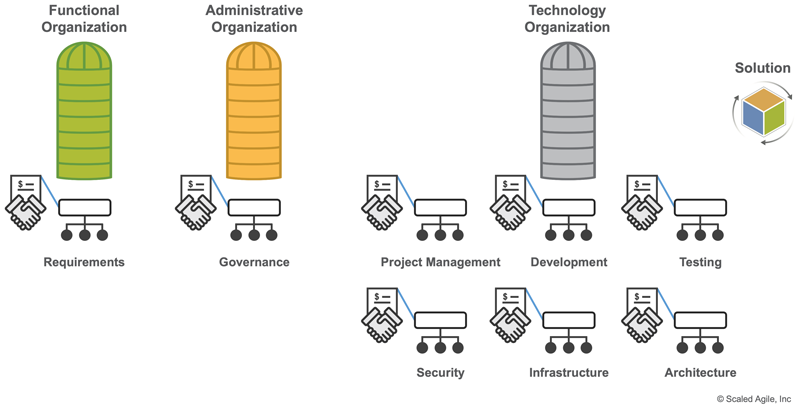
As a result, the funding (and therefore control) for delivering a solution is spread across disparate functions that are often locally sub-optimized. For example, it’s common for an Infrastructure branch to default to historical data to budget cloud and communications contracts as an aggregate, without understanding the current consumption and future needs of the solutions using those resources. Infrastructure may not be involved early and throughout the development of a new solution. When that solution requires capacity not included in the annual planning process, Infrastructure can be caught off-guard, and then become a bottleneck, potentially delaying solution delivery. Similar delays can occur with testing, security, and other branches. It’s also difficult to tie the consumption of these limited resources back to the appropriate solutions and value streams. In the U.S., this last challenge has prompted the adoption of Technology Business Management (TBM) to gain better visibility into how IT funds are spent [1, 2, 3].
Based on the principles of Lean Budgets and Guardrails, Figure 2 offers a better solution. It assumes that the organization has identified end-to-end development value streams, for example, all of the financial systems in an agency, all of the solutions in each value stream (GL, AR, AP, Payroll, grants management, etc.), and the priorities for horizons of investing for each solution in the coming budget year.
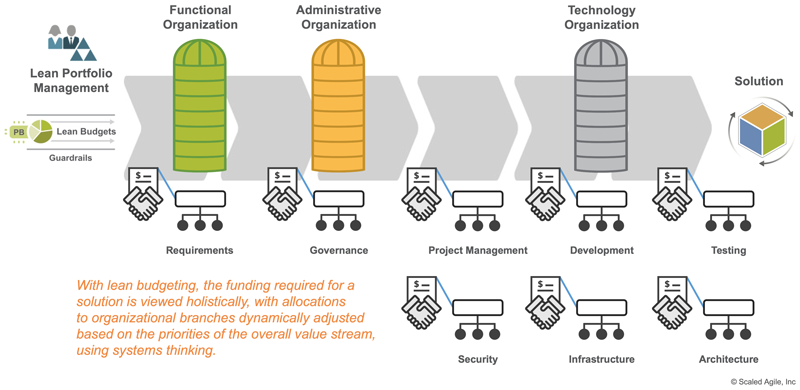
Instead of each branch (Infrastructure, Security, Testing, etc.) submitting siloed departmental budgets, the leaders contribute their funding needs to Agile Portfolio Operations (or the equivalent office in large programs) to support each development value stream. Based on the vision and roadmap for each of these value streams, this group consolidates and negotiates priorities, along with forecasting the anticipated funding level. To build the funding requirements collaboratively for the coming year, trade-offs can be made using exercises such as Participatory Budgeting (also see Lean Budgets).
For example, a financial system’s development value stream may have requests from Infrastructure to do a major modernization initiative in the next fiscal year to move all remaining solutions to the cloud. However, the functional area might raise a higher priority request to adapt all solutions to comply with the new tax laws so that payroll for employees and payments to suppliers will be correct when the law takes effect the following year. Given a limited projected total budget for the entire development value stream, the trade-off in participatory budgeting might be to defer the cloud migration for the least used systems until the following year, freeing up funds to build the new complex taxation rules into the applications. This demonstrates collaborative systems thinking across silos applied to the budgeting process for development value streams.
The net effect is that once the shift to lean budgets is complete, the annual budget requests are still reviewed by the agency CIO and forwarded for consideration in the overall federal budget lifecycle process. However, now the budget will be organized by development value streams, not by individual branches or projects. The funds that flow down in the final appropriation and apportionment will also be subsequently allocated to the development value streams. It will then be up to the decentralized decision-making of the leaders in each development value stream to determine how the funds will be used throughout the year (a key to enabling agency agility).
Use Agile Metrics to Track Program Spend and Flow of Value
To ensure the government is getting the intended value for money spent, lean budgets also require a different set of metrics for oversight and governance. Traditional development practices depend on models such as Earned Value Management to formulate estimates of final time and cost based on planned versus actual progress and expenditures. Instead, Lean-Agile development uses real-time, objective evidence of progress, based on working features of the system (whether new development, enhancements, or fixes) that are delivered every Program Increment (PI). Actual cost and capacity consumed per feature can be compared to planned cost and capacity to generate a predictability index that would be the most accurate indicator of overall program performance.
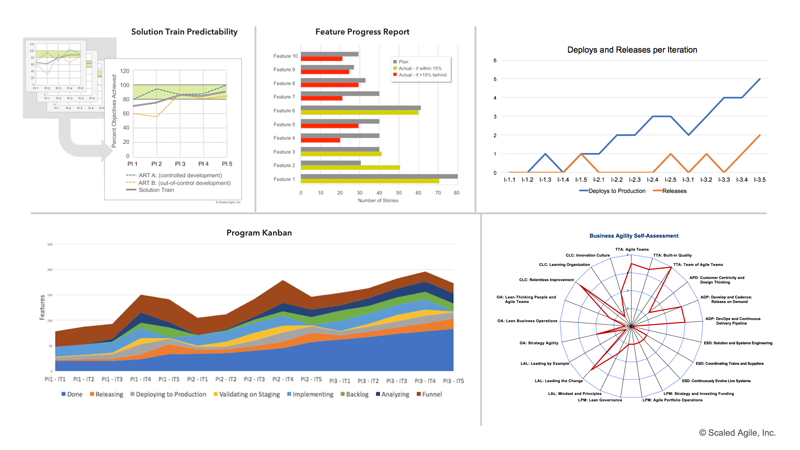
Other tools—such as feature progress charts, program Kanban boards, burn-up charts, and continuous flow diagrams (Figure 3)—also make program performance highly visible and transparent, enabling better fiduciary control. Agencies adopting TBM may consider the automated tools designed to support that framework to further enhance the visibility, management, and decision making of technology expenditures.
Exercise Fiscal Governance with Dynamic Budgeting
Lean budgeting using SAFe provides two important advantages over traditional budgeting. First, because each development value stream consists of long-lived ARTs that plan and forecast in cadence and synchronization, the visibility and predictability of spending improves significantly. Labor costs do not fluctuate wildly, and they can be easily allocated to individual features delivered each PI. Giving fiduciaries a seat at the table in Lean Portfolio Management (LPM) activities and backlog refinement workshops also provides real-time visibility into how spending is aligned to agency priorities. Attending PI System Demos offers those fiduciaries exposure and thus confidence in the fit-for-use and fit-for-purpose of what was actually delivered in the PI. Financial executives often comment that once their organization made the shift to Lean budgets, they had greater visibility and could execute their fiscal responsibilities more effectively.
The second advantage to Lean budgets is dynamic budgeting. Internal and external forces create more change and uncertainty for government agencies than ever before. All processes, including how technology budgets are created and managed over time, must adapt to enable the organizational agility necessary for agencies to respond dynamically to meet mission requirements. Lean budgets using SAFe provide that flexibility.
In the example illustrated in Figure 4, an agency serving veterans has four major development value streams with solutions that provide the services shown in the graphic. Notice at the cadence-based boundary between PI 2 and PI 3 that something has occurred requiring a significant shift in agency priorities. Responding to this change will necessitate a shift in resources and their associated funding.
An agency that has optimized for agility can respond quickly by re-allocating teams or trains to the development value streams supporting the new priorities. Over time, as the theme of agility permeates everything from architectural decisions to contracting strategies, such a shift can be made by simply changing the backlog of work for one or more ARTs.
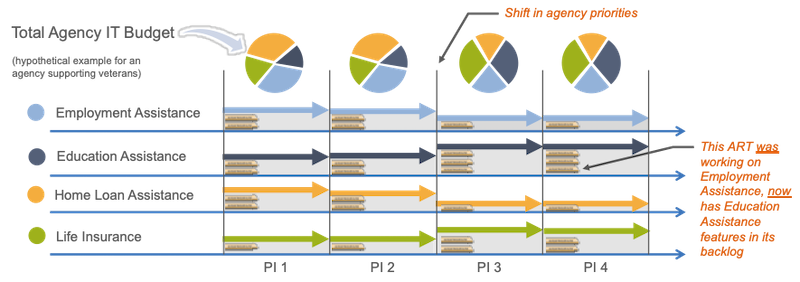
In this example, one of the ARTs that had been working on features for systems in the Employment Assistance development value stream will now have features from the Education Assistance development value stream in their backlog starting in PI 3. Of course, this assumes that the technical skills of the ART are appropriate for the solutions in both value streams. If that’s not the case, it may be necessary to change personnel on one or more trains. The potential delays, unplanned costs, and effect on team morale justify the cost and effort to design systems and contracts for maximum agility.
Address “Color of Money” Concerns
Among the common concerns regarding Lean budgets in a government context are the statutory restrictions frequently placed on appropriated funds. Funding authorizations can have strict limitations, such as the time window in which the funds must be spent, the kinds of work activities allowed, and many more. The rules governing how every dollar (or euro, etc.) can be allocated are incredibly complex and beyond the expertise of most ART personnel.
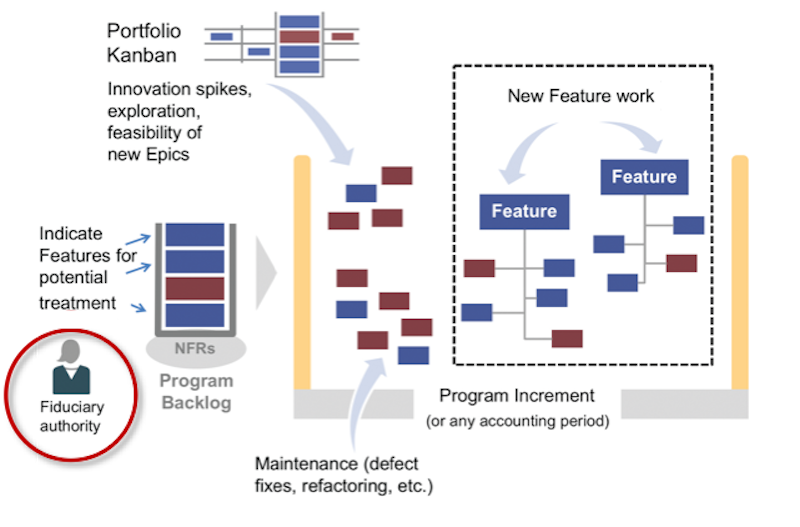
A simple, effective solution is to include in each backlog refinement workshop fiduciary authorities who have the necessary funding classification expertise. Being included in the refinement discussions lends an understanding of the work to be performed, allowing the fiduciary representative to apply funding codes to each backlog item that then follow the item throughout its entire lifecycle. Concerns related to the funding of prioritized work in the backlog can be raised during refinement and then resolved before any work is performed. This is an instance where an automated Agile Lifecycle Management (ALM) tool is strongly recommended. All of the major tool providers support the metadata tagging of backlog items required for tracking and reporting by funding classification needed in the government context.
Moving Forward
The next key concept for adopting SAFe in Government is Applying Lean Estimating and Forecasting in Cadence.
Next
Learn More
[1] Leffingwell, Dean. Agile and TBM: transforming the business of IT for the better. Sep 11, 2018. https://www.apptio.com/emerge/guests/agile-and-tbm-transforming-business-it-better [2] Accelerating the Mission: Recommendations for Optimizing Federal Technology Cost and Value in the Age of FITARA. https://www.tbmcouncil.org/us-federal-it-cost-commission [3] Accelerating Business Value with SAFe and Technology Business Management (white paper). https://scaledagileframework.com/wp-content/uploads/2019/04/White_Paper_TBM_DIGITAL.pdf
Last update: 10 February 2021





